
This post was most recently updated on March 10th, 2024
Header bidding means your ad space gets the best price. Instead of selling to one buyer at a time, multiple ad networks bid simultaneously, ensuring you get top dollar. Publishers see 30-50% more ad revenue with this method.
Think of it like a real-time auction for your ad space. Instead of giving priority to one ad network, everyone gets a fair chance to bid on your inventory.
With Digiday reporting that Sizmek found 60% of the top 30,000 websites are using header bidding vendor tags on their pages. The biggest benefit of header bidding is that it helps publishers get higher header auction rates for their unsold inventory with established publishers like The Telegraph claiming to have increased their programmatic revenues by 70% with their implementation of header bidding.
Clearly, there can be enormous revenue uplift benefits for publishers to move away from the waterfall auction and into header bidding. Though as publishers embrace header bidding they’re finding the drawbacks of an Open-Source Header Bidding Wrapper like the Prebid wrapper and are moving to more sophisticated setups to battle page latency, brand safety, revenue discrepancy, etc.
For a publisher of that size and traffic to increase programmatic earnings by 70% is staggering! Although not every publisher might see such dramatic increases, a lift in earnings is imminent when implementing header bidding, especially through MonetizeMore.
However, this technology is not without its challenges, and as usual, many publishers struggle to understand the header auction process, implementation of header bidding, and everything that goes with it. With so many companies offering header bidding services apart from the open-source solutions available on the market, it is often hard to cut through all the noise.
Whether you’re an up-and-coming publisher trying to maximize their earnings or a premium publisher with millions of visitors, learn the A-Z of header bidding in 2024 through our guide.
Let’s get started!

Header bidding has largely replaced the waterfall model due to its superior ability to maximize revenue for publishers. While it brings some complexity, the benefits almost always outweigh the effort.
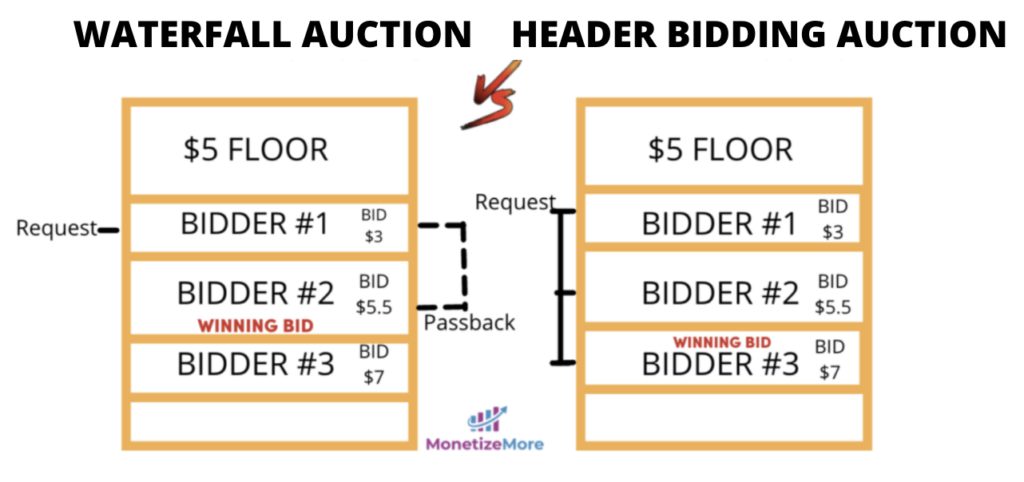
Here is a table breaking down header bidding vs waterfall:
| Feature | Waterfall | Header Bidding |
|---|---|---|
| Bidding Process | Ad requests flow down this hierarchy until an ad is filled. | All ad networks get to bid simultaneously on your inventory in a real-time auction. The highest bidder wins. |
| Request Flow | Sequential, one network at a time | Simultaneous auction among all networks |
| Efficiency | Less efficient, lower bids | More efficient, higher bids |
| Revenue | Lower revenue potential | Higher revenue potential |
| Control | Limited control | More control over ad selection and pricing |
| Complexity | Simpler to set up and manage | More complex to set up and manage |
| Latency | Potentially higher latency | Potentially lower latency |
A waterfall bid refers to a request for an ad that gets sent from one ad exchange to the next in sequential order if the previous bid didn’t meet the publisher’s price floor (the minimum price for their ad space).
Why header bidding is better: Header bidding solves the waterfall’s problems by running a simultaneous auction across all ad exchanges, ensuring the highest bidder wins, and ultimately maximizing overall ad revenue.
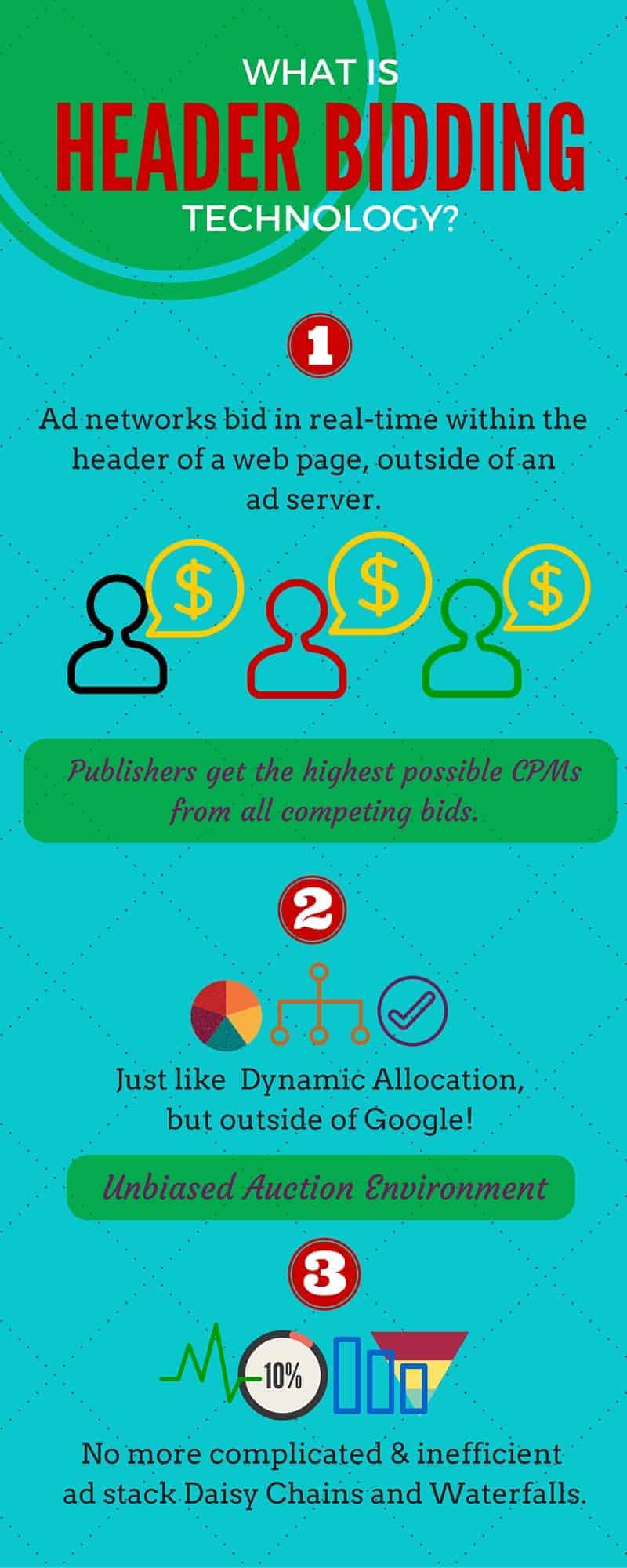
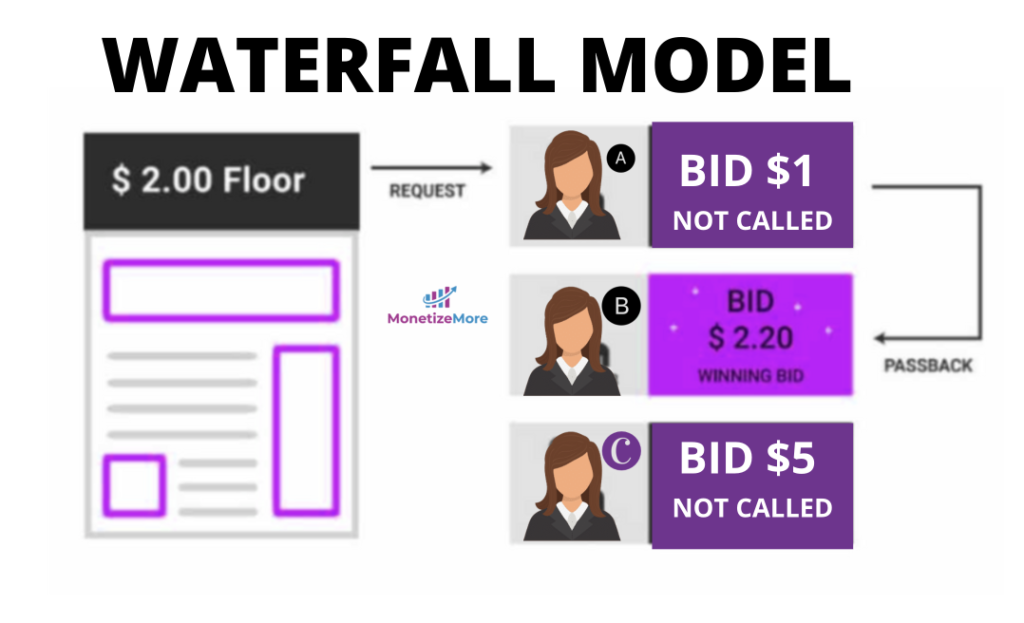
The reason why the waterfall bidding or the daisy-chain system was replaced was the price your impression sells for barely even accounts for its real value.
In the waterfall auction, unsold inventory is put forward to the top-ranked ad exchange, based on size, rather than to the highest bidder. If nobody in that tier bids here, it gets passed down to the 2nd tier and the cycle continues until an advertiser bids for it during that bidding time.
Yield risk: With the traditional programmatic waterfall model, the publisher ad server picked partners to serve impressions based on their average historical yield. However, this variable is known to be a bad predictor of what an ad impression is worth. Platforms like Google Ad Exchange that can bid impression by impression also get an unfair advantage. It resulted in publishers managing their ad inventory not based on the real value, but an assumption of what an impression was worth.
Fill risk: The publisher ad server would often serve ad impressions to exchange with the highest average rate, but sometimes the exchange couldn’t fill those impressions. It also requires the publisher to have a plan B in place if they want to sell the impression at all. The plan B could be to call out to another exchange or to pass back to their primary ad server for the second round of ad decisions where the whole header-auction process might repeat itself. Publishers need to know if they can fill their ad impressions before they call the exchanges which they can’t do with the waterfall structure.
Passback issues: Because of the complexity of the Google waterfall method, publishers are faced with the challenging and time-intensive task of managing, waterfall optimization, and reporting. Typically they need an ad operations team with access to multiple platforms and a lot of time to handle the setup. In reality, the publishers’ marketplace is chaotic in the waterfall bidding process as it is not automated.
Header bidding is like holding a simultaneous auction for your ad space on your website. Here’s what happens:
An example would be as follows: A visitor visits Forbes.com, and within a few milliseconds the header bidding code gets executed, makes a call to the demand partners the publisher is signed up with (AppNexus, etc.) and gets them to place a bid. The winning bid is decided between all the available demand-side platforms, and the highest bidding is selected.
That information is passed directly to the publisher’s ad server. Within the primary ad server, based on how the publisher has set up their system, header bidding partners will compete against all other sources of demand. Once the overall highest bid is selected the ad gets displayed on the publisher’s website, and the publisher enjoys the maximum yield for their website impressions.
There are barely any reporting discrepancies since it’s one single auction with sequential chaining.
Publishers can control which sources are allowed to bid in header bidding, which means all demand-side platforms in these simultaneous auctions. They have full control over increasing the floor price they charge for premium inventory.

Header bidding is beneficial for both publishers and buyers/advertisers with the focus being on publishers. So, what are the advantages of header bidding?
Some of the benefits for publishers include:
Increased competition: Advertisers/demand partners can bid on every impression on the website increasing competition and giving them access to higher-quality premium ad inventories. The increased competition also means an increase in bid prices and higher earnings for publishers. The floor price plays a significant role for the publishers who are simultaneously running both private auctions & open auctions.
More demand partners: With header bidding, publishers can integrate and get access to advertisers from multiple demand sources, similar to the point mentioned above, and most of the time results in a higher yield.
Increased transparency: Almost any business loves transparency, and that’s exactly what a publisher is. He/she is a person running a digital advertising monetized business. With header bidding, publishers are back in the driving seat with control to optimize their ad stacks a lot better than with traditional setups. Bid transparency is possible since publishers can sell ad space on an impression basis and see how much they are worth.
No more need for passback: A publisher does not need to push inventory back and forth as with traditional waterfall setups. It decreases the wastefulness of lost impressions and reduces latency.
Maximum Ad Revenue for Publisher Inventory: MonetizeMore has been able to grow its publishers’ ad revenue by 36%. Making your ad inventory and even video inventory pop out to a bunch of advertisers is the pathway to driving better CPMs and revenue growth. Increased ad revenue benefits publishers when their main aim is monetizing more of their premium inventory,
Better Yield: Since you are not solely relying on a single SSP, this allows smoother dynamic allocation of ad impressions & increased fill rate. You can sell your ad space on a per-impression basis easily.
The benefits of Header Bidding for advertisers are as follows:
Increased inventory for advertisers: Buyers can now via header bidding get access to all of the publisher’s ad inventory regardless of them using AdX or not. This means the potential for accessing more audiences and with that reaching their campaign goals exist. It also means that there is more data available for DSPs which can further be used to improve advertising campaign results.
Improved forecasting: It’s great to be able to generate accurate forecasts. With header bidding, better forecasting is imminent for buyers since they have access to more constant inventory over longer periods of time.
Transparency: Media buyers can check out the publisher’s impressions & others stats directly from the source before programmatic ad buying.

Originally big industry names like Amazon, Criteo and a few other opened the market to header bidding with their header bidding products. Similar to what is needed today, a publisher would implement the code in the header, connect to DFP and benefit from the increase in ad revenue for publishers.
The issue with this approach was however that most of these solutions only allowed one source of demand for the publisher.
To increase competition within demand partners a publisher typically needed to set up multiple header bidding solutions to run more demand sources.
This meant more work in DFP with new creatives, line items and so forth needing the be created and managed.
It was also a very cumbersome process for publishers, which many could not afford to implement and as you can imagine, the effects on website speed weren’t all that great either.
Header bidding wrappers were introduced to solve this issue. With a header bid wrapper, a publisher can integrate multiple demand sources within the head of their web page.
No more additional individual setups were needed which saves the publisher a lot of effort, time and money.
Using the combined header code publishers can run multiple header bidding partners simultaneously and fully enjoy the benefits that go with it such as mentioned in the benefits section above.
With wrappers, the issue of site speed also should get solved. Currently, there are multiple header bidding wrappers available on the market with a mix of ad tech company developed and open source solutions.
Open source solutions include the likes of Prebid.js and PubFood.js, while ad tech solutions include MonetizeMore’s very own header bidding solution PubGuru and much more. Although the process a publisher understands is fairly simple you still need a skilled in-house team or ad tech company to help with header bidding implementations and monthly upkeep.
Related Read: https://www.monetizemore.com/blog/how-to-debug-your-header-bidding-setup/
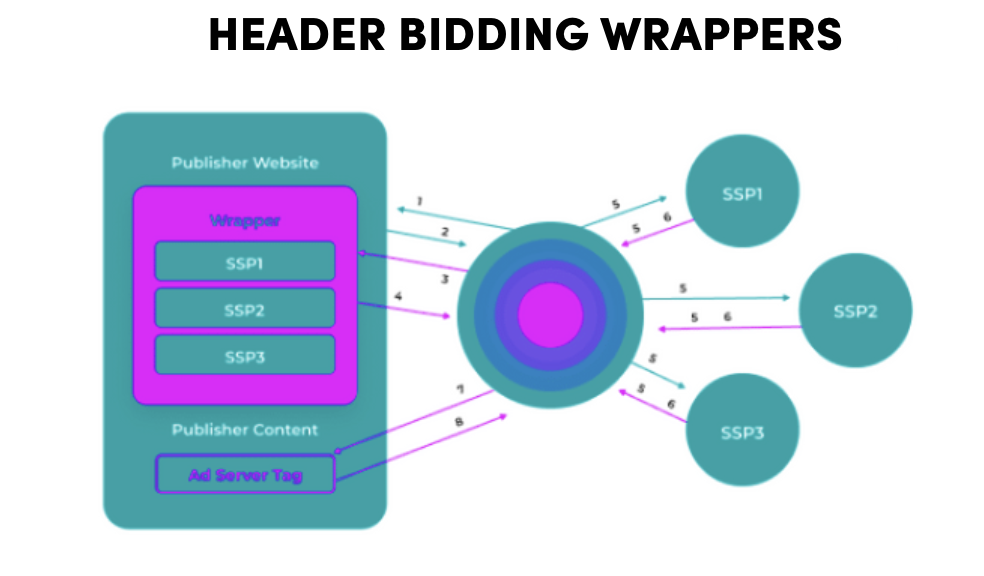
Prebid.js aka the popular wrapper is one of the best header bidding wrappers out there.
Publishers can easily install line items through Prebid.js & control several ad calls with an ad server.
The Good:
The Bad:
Simply said, Google AdSense is Walmart compared to Header Bidding which is Chanel. With Google’s market share falling compared to its’ fiercely competitive advertising partners, header bidding’s popularity is the reason for the switch.
You can integrate Google AdSense into header bidding, but this system allows you to astronomically extend the range of ad exchanges that will be able to bid on your inventory. More ad spending is flowing through the publishers’ marketplace as well.
Implementing header bidding can be a little technical, but I’ll break it down into manageable steps and considerations:
1. Choose a method
<head> section of your website. Popular options include the open-source Prebid.js wrapper.2. Select a header bidding partner
3. Integrate demand partners
4. Configure your ad server:
5. Testing and Optimization:
Don’t forget to look into:
For implementation advice about your specific setup and needs, I urge you to get in touch with our team here.
Ad server configuration is also a very important step and as you can imagine your ad server, whether it’s AdX or something else, needs to be configured to support your header bidding solution.
For a detailed breakdown of how to implement header bidding, we put together this page explaining the benefits of Prebid’s open-source technology.
Related Read: https://www.monetizemore.com/blog/how-implement-header-bidding-advancedads-wordpress/
Header bidding and Open Bidding (formerly Exchange Bidding), while similar, have some key differences. Header bidding is a more diverse programmatic advertising technique where publishers offer their ad inventory to multiple ad exchanges simultaneously through a real-time auction that happens in the user’s browser. This increased competition helps publishers get the best prices for their ad space.
The goal of header bidding is to add competition to Google Ad Exchange or Google AdX, allowing bidders to preview auctions & win impressions they valued by bidding one cent more than the winning bid.
Open Bidding, on the other hand, is Google’s server-side implementation of a similar concept. In Open Bidding, Google Ad Exchange (AdX) competes with other ad exchanges and SSPs directly within Google Ad Manager (GAM), the publisher’s ad server. This eliminates the need for multiple calls to external servers, potentially improving page load speed and offering a slightly more streamlined experience.
In Open Bidding, server-to-server connections are used, which are faster than page tags, resulting in a reduction in page latency an increase in ad viewability, and greater yield. This is somewhat of a Google AdX privilege for Open Bidding partners.
Google AdX Privilege Takeaways:
Compared to Google’s Open Bidding, Header Bidding’s setup & user interface is more complicated. However, publishers have more freedom with header bidding.
Furthermore, the auction takes place on an ad server instead of in the user’s browser, which means that Open Bidding has significantly reduced latency compared to header bidding.
Header Bidding is more transparent compared to Open Bidding as publishers will never know why a certain advertiser won the bid in Open Bidding.
When it comes to better match rates for cookies, header bidding wins the game here where cookie syncing permits easy data exchange while matching users with their respective profiles on the programmatic media buying database.
Video Header Bidding continues to grow at an exponential rate as a platform and via demand from users. Many publishers want to stake their claim with video; hence video header bidding is something to keep an eye on. However, this is not without its challenges. Not only does video act differently (no header code), but the video advertising space is different compared to display advertising. There is still a lot of disagreeing opinions about the use of video header bidding and what the effects would be, but potentially as with traditional header bidding it could help publishers gain back inventory control and increase their yield.
Since the word “header bidding” is on almost every serious publisher’s lips, demand partners are joining this programmatic advertising space and trying to integrate themselves left and right. You might think that this is all good. However, publishers need to be cautious and ask the right questions when adding new demand partners. Publishers will need to get extremely good at weeding out the bad from the good, or else overall performance will suffer.
As with most ad tech developments, the evolution of header bidding technology is imminent in the advertising space. As with Google’s Exchange Bidding, many believe that the next step for header bidding is to move the technology from the server to server-side. This means implementation takes place on a publisher’s ad server which comes with a whole range of benefits including easier partner integration, better page load speed, and more efficient bidding.
Client-side header bidding occurs directly within the user’s web browser. When a page loads, the browser sends out multiple ad requests to different ad exchanges, runs a real-time auction, and then displays the winning ad. While this brings increased revenue potential for publishers, it can also slow down page load times, especially on less powerful devices.
Server-side header bidding shifts the auction process away from the user’s browser and onto a remote server. The publisher’s ad server handles the communication with ad exchanges and runs the auction. This reduces the burden on the user’s browser, improving page speed and the overall user experience. Server-side header bidding also gives publishers greater control and flexibility since they aren’t limited by the browser’s capabilities.
Ever wondered if any of your competitors have implemented header bidding or not? With this neat little extension called the Headerbid Expert from AppNexus you can easily understand what your competitors are doing in the programmatic media buying world.
It’s very easy to setup and use. For help with the installation check out MonetizeMore’s guide on How to Use the Headerbid Expert Chrome Tool.
What the tool does is show you which demand sources are competing via header bidding on a web page, the latency of each one of those sources and more. Here’s a screenshot from a page on The Telegraph.
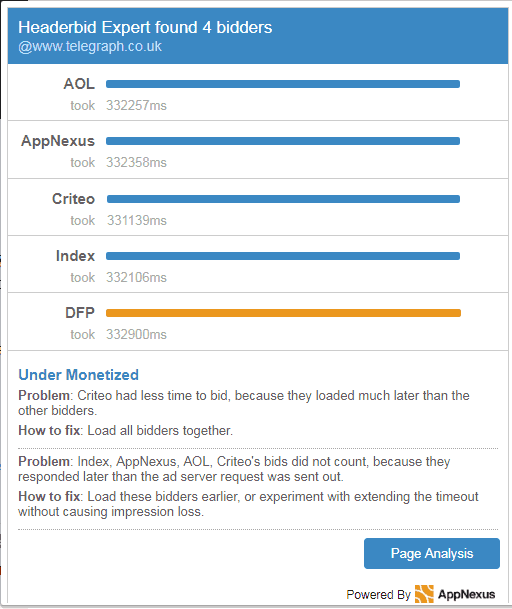

Since MonetizeMore is an industry leader within the top header bidding providers list and publisher monetization platforms, we have been developing and implementing header bidding for publishers for 11 years. Our Header Bidding product that was formerly called MonetizeMore Demand has now evolved into an advanced header bidding wrapper platform called PubGuru.
With our Pubguru Header Bidding Platform, we’ve developed and integrated a range of ad optimization tech and tools while remaining transparent to our publishers. Here’s our product video explaining how simple it is to implement PubGuru on your website.
The PubGuru setup comes with a whole list of benefits such as:
Find out more about MonetizeMore’s PubGuru header bidding platform here.
The pros of working with a header bidding partner often outweigh the cons, especially for publishers who lack in-house ad tech expertise or want to maximize revenue without a huge time investment.
Pros
Cons
Think of a header bidding company like a partner for your ads. Picking the right one means finding someone who helps you reach your goals. Here’s what to keep in mind:
What Do They Offer? Some companies focus only on header bidding, others are full-service ad experts. Do you need the basics or the whole package (like help with tricky privacy laws or fancy video ads)?
How Do They Work? Is it an easy “do-it-yourself” setup, or do they offer extra hands-on help? Match this with your own tech skills and how much time you have.
What’s Important to You? Is it all about making the most money, or do you care about keeping your website fast too? Some companies might be slightly less profitable but better for your users.
When Do You Get Paid? Money matters! Some companies pay quickly, others might take months. Make sure their payment terms work for your business.
Can You Get Help? A good header bidding company is like having an extra ad expert on your team. Do they give you someone to talk to when you have questions or want to try new things?
MonetizeMore Demand is a Header Bid Solution that transforms your ad stack into an unbiased auction environment. Competing for ad networks must engage in a cut-throat bidding war to win your ad inventory. Empowering publishers to earn the highest possible revenues, MonetizeMore Demand has consistently boosted publisher CPM’s from 30% – 50%.
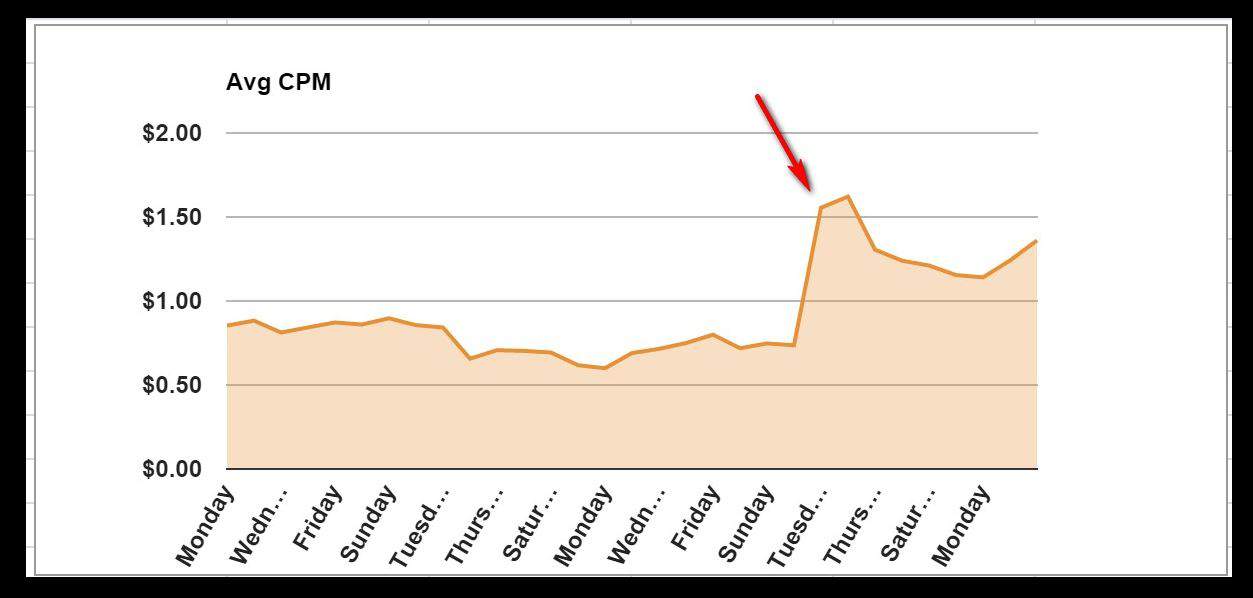
Case Study: 113% increase in Avg. CPM for Wuxiaworld.com after implementing MonetizeMore Demand.
Top demand sources bid for each ad impression at the exact CPM value that they pay within your GAM account. It’s just like Dynamic Allocation – but outside of Google!
Reap the benefits of the following:
It’s a plug-and-play solution that pits warring ad factions against one another to drive up CPM’s and ensure each ad impression yields the highest possible revenues.
Stop selling your inventory for less than its worth. Try out the award-winning MonetizeMore Demand Header Bid Solution today!
Publisher Inventory is auctioned through programmatic header bidding to multiple demand partners for greater yield and maximum ad revenue.
Prebid is the open-source header bidding wrapper solution made to optimize the whole header bidding process.
The main difference between header bidding and the waterfall is the auction process. In the waterfall, demand sources are prioritized based on a set hierarchy, with the highest-paying demand sources getting the first opportunity to bid. In header bidding, all demand sources have an equal opportunity to bid on each impression simultaneously.
In general, header bidding has been shown to generate higher revenue for publishers compared to the waterfall, because it creates a more competitive environment for demand sources and allows publishers to monetize all available impressions.
Header bidding can be more complex to set up and manage compared to the waterfall, as it involves integrating multiple demand sources and configuring the auction process. However, there are tools and technologies available to simplify the process, such as header bidding wrappers and demand-side platforms (DSPs).
Yes, header bidding and the waterfall can be used together in a hybrid approach known as header bidding with fallback. This approach allows demand sources to bid on impressions through header bidding, but if no bid is received, the impression is passed to the waterfall.
Header bidding can help premium publishers maximize revenue by creating a more competitive auction environment for their ad inventory and enabling them to monetize all available impressions.
Unlike traditional programmatic advertising, which uses a waterfall auction system that prioritizes certain demand sources over others, header bidding allows all demand sources to bid on an impression at the same time, increasing competition and revenue potential.
There is no one-size-fits-all answer to this question, as the optimal number of demand sources can vary depending on a variety of factors such as traffic volume, ad format, and audience demographics.
Key performance indicators (KPIs) for measuring header bidding success may include revenue, fill rate, ad viewability, and user engagement.
Optimizing your header bidding setup may involve experimenting with different demand sources, adjusting ad formats and placements, and continually monitoring and analyzing performance data.
Some potential risks of header bidding include ad fraud, data leakage, and revenue cannibalization.
To mitigate risks associated with header bidding, it is important to implement measures such as fraud detection and prevention tools like Traffic Cop, data privacy policies, and careful monitoring and analysis of performance data.

With over seven years at the forefront of programmatic advertising, Aleesha is a renowned Ad-Tech expert, blending innovative strategies with cutting-edge technology. Her insights have reshaped programmatic advertising, leading to groundbreaking campaigns and 10X ROI increases for publishers and global brands. She believes in setting new standards in dynamic ad targeting and optimization.

Paid to Publishers
Ad Requests Monthly
Happy Publishers
10X your ad revenue with our award-winning solutions.